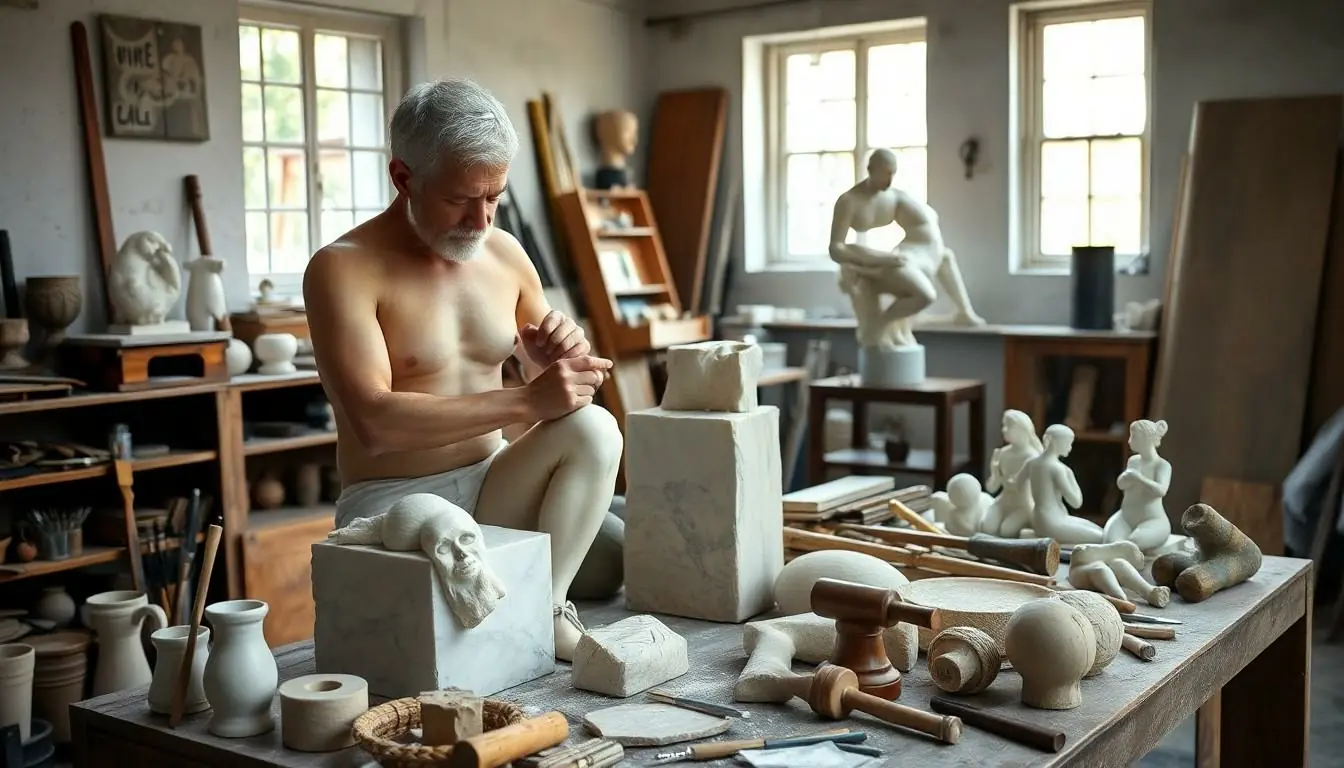Table of Contents
ToggleNude sculpture has a way of making art lovers blush and giggle, all while appreciating the beauty of the human form. It’s like a cheeky wink from history, reminding us that art can be both serious and playful. From ancient Greece to modern galleries, these works challenge societal norms and invite viewers to embrace vulnerability.
Imagine strolling through a museum and encountering a stunning marble figure that seems to breathe life. Each curve and contour tells a story, revealing the artist’s passion and creativity. Whether it’s a classic piece or a contemporary twist, nude sculptures spark curiosity and conversation. They remind us that beneath our clothes, we’re all just beautifully imperfect beings. So, let’s dive into the fascinating world of nude sculpture and explore why these timeless pieces continue to captivate hearts and minds.
History of Nude Sculpture
Nude sculpture has a rich and varied history that showcases evolving artistic expressions and cultural attitudes towards the human form.
Ancient Civilizations
Ancient civilizations laid the groundwork for nude sculpture, emphasizing ideal beauty and human anatomy. In ancient Greece, artists created lifelike representations celebrating athleticism and divine perfection. Statues like the Discobolus highlight the mastery of form and movement. Meanwhile, ancient Rome adopted and adapted these ideals, demonstrating realism through artistic techniques. Sculptors like Praxiteles and Polykleitos inspired a focus on proportion and harmony, influencing generations of artists. In addition, the emphasis on nudity in these sculptures often conveyed philosophical beliefs about humanity and nature.
Renaissance Influences
The Renaissance marked a renewed interest in classical techniques, which significantly impacted nude sculpture. Artists such as Michelangelo and Donatello revived the human figure’s idealization, blending emotion with anatomical precision. Michelangelo’s David exemplifies this fusion, capturing both physical strength and psychological depth. Additionally, Renaissance artists explored themes of mythology and religion, using nudity to convey deeper meanings and human experiences. Statues from this era celebrated both divine and mortal forms, showcasing how artworks aimed to evoke a sense of wonder and introspection among viewers.
Techniques and Materials

Nude sculpture showcases a variety of techniques and materials, reflecting both tradition and innovation. Artists employ different methods to create lasting impressions with these works.
Traditional Techniques
Carving emerged as a primary method, with artists using chisels and mallets to shape marble or stone. Sculptors traditionally relied on tools like gouges and rasps, allowing them to achieve intricate details. Adding clay to the process enabled preliminary models, which facilitated refinement before final execution. Techniques such as modeling with wax and clay also proved invaluable for larger sculptures, permitting a three-dimensional exploration of poses. These conventional approaches celebrated the human form and captured the essence of beauty and grace in their simplicity.
Modern Innovations
Modern sculptors embrace a wide array of materials and techniques beyond traditional stone and marble. Materials like bronze, resin, and steel became popular, allowing for diverse forms and textures. Many artists experiment with mixed media, combining elements such as glass or fabric to enhance their sculptures visually and conceptually. Digital technologies, including 3D printing, expanded creative possibilities, facilitating complex designs that were once unimaginable. In this evolving landscape, contemporary artists challenge perceptions of nudity, engaging viewers in new dialogues about identity and expression through innovative approaches.
Cultural Significance
Nude sculpture holds profound cultural significance, reflecting societal values and beliefs about the human form. This art form serves as a medium for exploring vulnerability and beauty.
Representation of the Human Form
Artists capture the essence of humanity through nude sculptures. Such works celebrate the human body, addressing themes of beauty, strength, and vulnerability. Ancient Greeks pioneered this practice, depicting idealized bodies that conveyed harmony. Sculptors like Praxiteles emphasized proportion, showcasing the relationship between form and emotion. Contemporary artists often challenge traditional representations, using nudity to provoke thought and discussion about identity and self-acceptance.
Impact on Society and Art
Nude sculpture influences perceptions of body image in society, sparking conversations about standards of beauty. Throughout history, these works have provoked varied reactions, from admiration to controversy. In modern art, nudity remains a powerful symbol of freedom and expression. Sculptors push boundaries, encouraging viewers to reconsider preconceived notions. This ongoing dialogue fosters a deeper understanding of human experiences and societal norms, solidifying the relevance of nude sculpture across cultures and eras.
Notable Artists and Works
Nude sculpture showcases a wide array of talented artists throughout history. Exploring both classical and contemporary creators reveals distinct styles and philosophies.
Classical Sculptors
Ancient Greece saw sculptors like Praxiteles elevate the human form to new heights. His work, Aphrodite of Knidos, captures sensuality and grace, setting a standard for idealized beauty. Polykleitos followed with his Doryphoros, exemplifying perfect proportions and balance. Rome embraced these ideals, highlighting a focus on realism in pieces such as the impressive statues found in the Vatican. Iconic works during this time communicated powerful philosophical messages about humanity, identity, and nature.
Contemporary Artists
Modern sculptors redefine the boundaries of nude representation. Artists like Henry Moore incorporate abstract forms, encouraging viewers to engage with the essence of the human experience. The expression of vulnerability remains relevant in the works of Marc Quinn, whose sculptures explore themes of body image and identity. Similarly, Kiki Smith utilizes materials such as bronze and glass to challenge traditional concepts of femininity and the human experience. Contemporary nude sculpture invites audiences to reflect on personal and societal narratives, fostering deeper connections with the art form.
Nude sculpture remains a powerful medium that transcends time and culture. Its ability to evoke emotion and provoke thought highlights the complexity of human experience. As artists continue to push boundaries and challenge norms, these works invite viewers to engage in meaningful dialogues about identity and self-acceptance.
The evolution of techniques and materials enriches the narrative surrounding the human form, ensuring that nude sculpture retains its relevance in contemporary discussions. By celebrating themes of beauty, strength, and vulnerability, these timeless pieces encourage a deeper appreciation for the artistry and the stories they convey. As one explores this captivating realm, the enduring impact of nude sculpture becomes increasingly clear.




